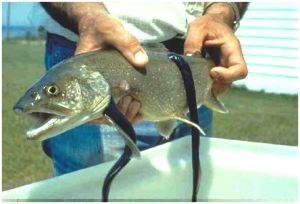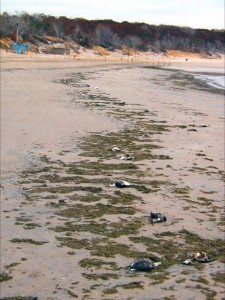The Dead Zone’s Effects on Lake Erie
Lake Erie may be on the verge of dying. Again.
In the 1960s, Lake Erie was proclaimed to be “dead.” The lake was full of algae and pollution, which led to many fish dying and tourists fleeing the beaches. Scientists identified phosphorus, a chemical which causes excess amounts of algae to grow, as being the culprit.
Many scientists predicted that the lake would recover completely, especially after the passing of the Great Lakes Water Quality Agreement in 1972 between the United States and Canada, which attempted to control the amount of phosphorus going into the lake. They were wrong. Lake Erie on its way to being completely dead once again.
John Gannon, a limnologist of Windsor, Canada, spoke on problems facing Lake Erie at the Reddin Symposium on Jan 22, at Bowling Green State University. Gannon is retired from the International Joint Commission Great Lakes Regional Office in Windsor.
Gannon shared his concern about the current levels of phosphorus in the lake. Phosphorus enters the lake through runoff from the rivers flowing through farms and cities. Phosphorus is necessary in the lake for feeding the plants and animals that call the it home. When the amount of phosphorus exceeds the needed amount to feed the organisms, it becomes a problem. Too much phosphorus may cause algae to run rampant in the lake. When the algae decomposes, it sinks to the bottom of the lake where it proceeds to absorb all of the oxygen, which leads to a “dead zone.” Fish are unable to survive in an area that does not have enough oxygen, which is what gives the dead zone its name.
The buildup of phosphorus in the lake is called eutrophication .
According to Gannon, during the ‘60s, scientists did studies on the water quality and fish, which is how the large amounts of phosphorus were identified as being the unbalanced nutrient in the lake. The public wanted action taken, which led to the water quality agreement. Many bans were placed on phosphorus in detergents.
The amount of phosphorus that declined in the lake in the 1970s and improved the water quality immensely, began rising again in the past several years, which has led to an increase in algae.
The dead zone is not the only problem facing Lake Erie at this time. Another key problem is the introduction of

Very few fish are able to survive the attacks of the sea lamprey, such as the one shown here. Photo courtesy of John Gannon.
invasive species. Invasive species are non-native plants or animals that have strong effects on their new ecosystem. An example of this is the sea lamprey. It is the oldest recorded invasive species in the Great Lakes, and as few as one in seven fish survive its attacks, according to Gannon.
Toxic chemicals, unplanned growth, habitat destruction and climate change have also had a massive effect on the lake over the years.
The Lake Erie Water Quality Agreement is currently being revised, after nearly 40 years. Gannon said that people can help out by supporting the negotiations and revisions concerning the agreement. They can also reduce the amount of household products they use that contain phosphorus, as well as lawn fertilizers containing the chemical.
“Give the Earth a chance. It will restore itself,” Gannon said.
For more information on the agreement between the United States and Canada see, http://binational.net/home_e.html
